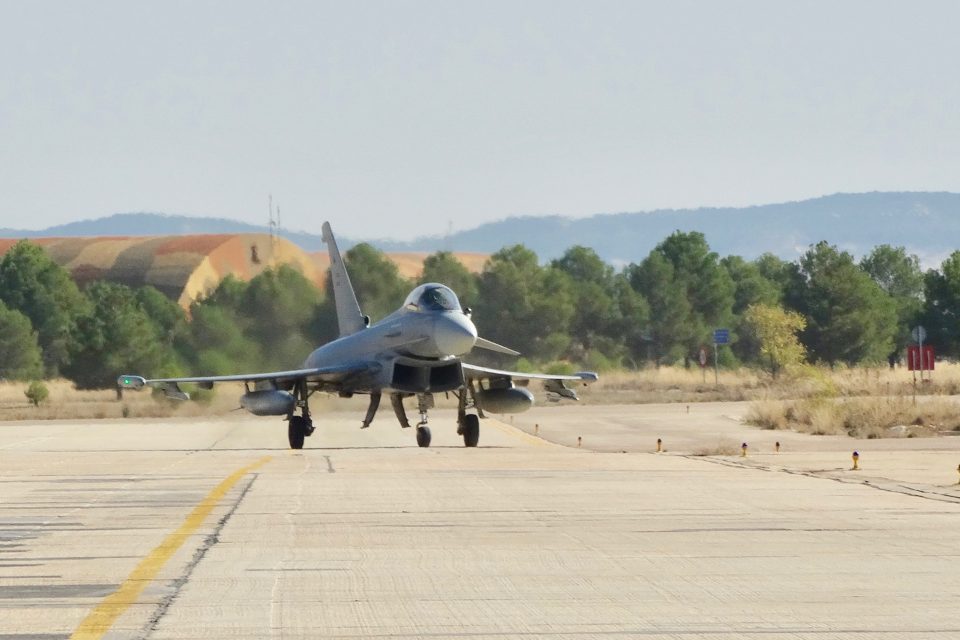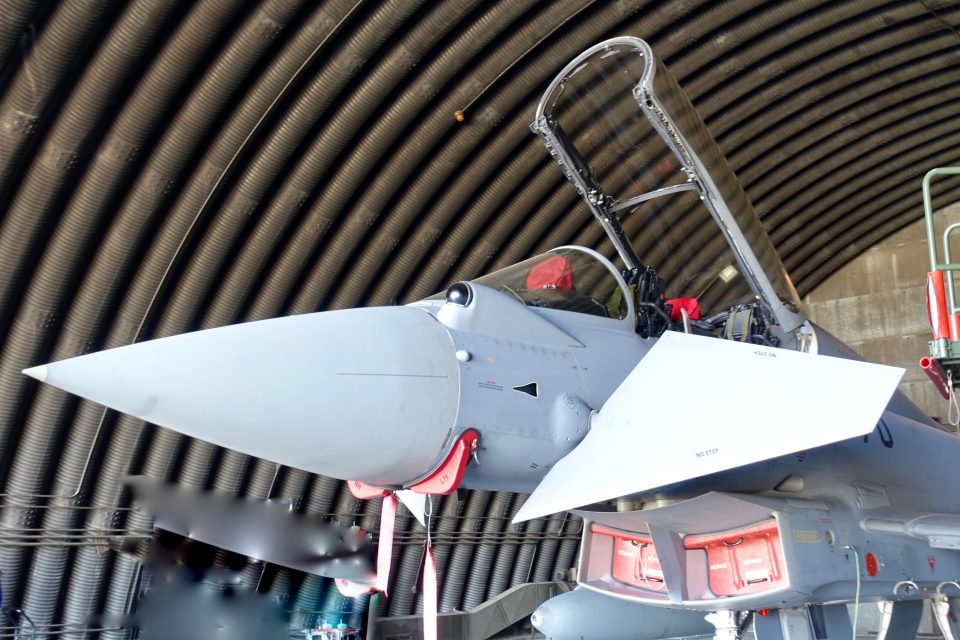2016-11-06 On November 2, 2016, Second Line of Defense visited the Spanish Eurofighter squadron based at Albacete, Air Base in Spain.
During the visit our hosts, Captains Antonio Duque Polo and Sergio Martinez Pėrez provided us an overview on Eurofighter, their recent deployment to Lithuania and the support structure on base for the Eurofighter as well.
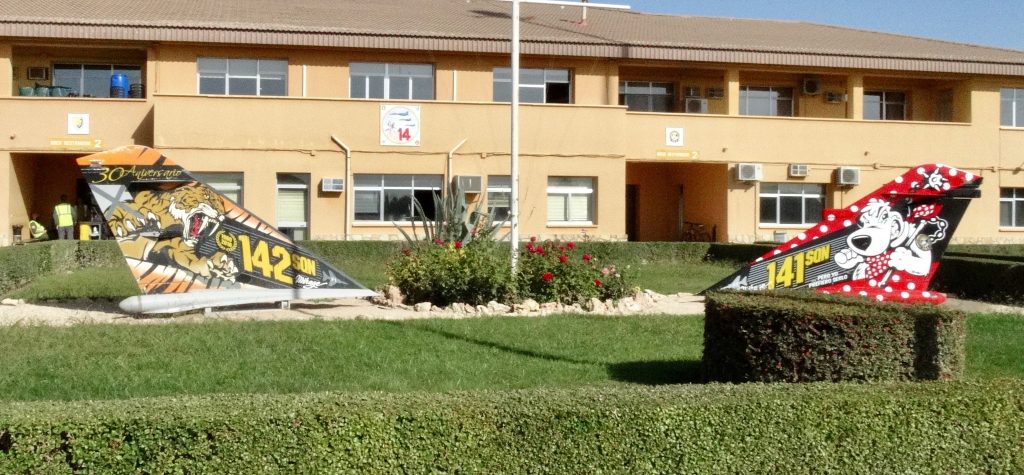
We will provide our interviews and analyses in future articles.
In this article, we are focused upon the photos, which we took that day and associated narrative for the visit associated with the photos.
In an article published on January 11, 2016 by the Spanish Air Force, the deployment earlier this year to the Baltics, which involved our hosts, was described.
On January 4, four Eurofighter planes took off from Albacete Air Base with Siauliai in Lithuania as their destination. Their aim was to join the VILKAS detachment and therefore carry out surveillance missions of the air space of the Baltic Republics of Estonia, Latvia and Lithuania. In this way, NATOs commitment to the carrying out of air policing in the Baltic has been continued.
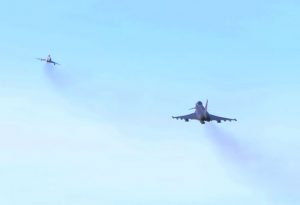
After four hours of flight and the re-fuelling of an Italian KC-767 in German airspace, the aircraft arrived without stopovers and without event at Siauliai. Following the relief of the previous nation Hungary, the first alert service was in place within days. Ahead, there are four months of air policing in the Baltic, under the command of Lieutenant Colonel Head of Force Juan Antonio Ballesta Miñarro.
The 14th Wing will act as the lead nation of the assets deployed in the Baltic; specifically, of the Belgian F-16s stationed at Amari, Estonia.
Deployment of VILKAS Detachment Personnel
On January 3, the act of bidding farewell to the first relief of the Air Force personnel that will form part of the VILKAS detachment, within the framework of Operation Baltic Air Policing, took place at Albacete Air Base.
The contingent is made up of 105 military personnel, as well as one other staff member, and it belongs mainly to the 14th Wing. It will unite with those that left from Spain with Siauliai Air Base, Lithuania, as their destination on December 27. The objective was to reach full operative capacity on January 8.
This is the third time that the Air Force has participated in this mission. From August 1 to November 30 2006, it did so from Lithuania and as the lead nation, with four C.14 Mirage F-1s from the 14th Wing. Later, from January 1 to May 4 2015, and with four C.16 Eurofighters from the 11th Wing, they carried out operations from Amari Air Base, Estonia. The Eurofighters from the 14th Wing will lead the missions during the first quarter of 2016: this time from Lithuania.
In total, approximately 230 personnel will form part of the detachment in the four months that the mission will last. Half way through it, a relief of crews, controllers, health workers and maintenance staff will take place.
The event was presided over by the Chief of Staff of Air Combat Command, Division General César Miguel Simón López, on behalf of the Chief of Staff of the Air Force, Air General Francisco Javier García Arnaiz. General Simón, who was accompanied by the Head of the 14th Wing and Albacete Air Base, Colonel Julio Nieto Sampayo, offered Christmas greetings to the members of the contingent and their families in the name of the Chief of Staff. He also expressed the wish that the detachment´s tasks will pass without event. Echoing the recent words of the President of the government, the general also reminded the attendant personnel that they are the “best ambassadors for Spain” outside of our borders.
Baltic Air Policing
“Baltic Air Policing” is a NATO mission framed within the principle of collective defence. It has as its aim the protection of the air space of the Baltic countries that lack their own resources to carry out air policing tasks.
(Also see, https://sldinfo.com/spain-takes-over-air-policing-mission-in-baltic-states/).
In our slideshow (photos credit to Chloe Laird, Second Line of Defense) we highlight a number of points during the visit.
Upon entering the base, the most recent historical aircraft flown by the squadron greet visitors. The next photos show our hosts Captains Antonio Duque Polo and Sergio Martinez Pėrez during the interviews.
We next walked to the Eurofighter simulator at the base where training is facilitated by time in an artificial intelligence environment. Duque is seen in the simulator as well as the SLD photographer and translator on the visit, Chloe Laird, currently studying in Spain in nearby Valencia.
We then went to the maintenance facilities where we had a chance to look at some second order maintenance on the engines and discuss with the crew chief the approach to maintenance of the engines. The Eurofighter engines are a solid achievement on the aircraft; because it is a modular engine, many of the repairs are done on base, but bench testing of engines is done at the Moron airbase. The Albacete air base is hoping to receive its own capability to bench test on base so that engines do not need to be sent to Moron for bench testing.
We then visited a maintenance hanger where Eurofighters were being worked on, including a two seat version of the aircraft.
We then crossed over to a hardened hanger where the latest two seat Eurofighter arrived, and is the latest software configured Eurofighter, namely, the version being flown by the RAF in the Middle East, which the RAF refers to as Operation Shader ready aircraft.
Because the simulator has not yet been upgraded to the latest version of software, training for this version is being done on this upgraded two seat aircraft on base.
And finally, on the way from the maintenance bays to the hardened hanger, we saw a Spanish Eurofighter in the process of landing at the base.
For Operation Shader, the RAF operates a version of Typhoon which they refer to as P1Eb. According to the RAF officer we discussed this modification with at RAF Lossiemouth, “P1 EB is a software upgrade, with minor hardware changes.”
According to November 27, 2014 article published on the RAF website:
“P1Eb is predominantly an air to ground capability upgrade; it provides enhancements to the Litening III Laser Designator Pod (LDP) and Helmet Equipment Assembly (HEA) (helmet mounted sight) integration, as well as with Paveway IV.
The LDP can now also be used seamlessly with the HEA to visually identify air tracks at long range, as well as identifying, tracking and targeting points on the ground.”
The Spanish are bringing a similar capability to their Eurofighters.
Earlier this year, the Spanish Air Force fired their first Paveway weapons from their Eurofighters.
A test team from the Air Force´s Arms and Experimentation Logistical Centre (CLAEX) has successfully carried out the first launch of an EGBU-16 (GBU-48) bomb from a Tranche-2 C.16.
The launch was carried out during the week of June 20 – 24 in the waters of the Gulf of Cadiz, and with the support of the CLAEX “El Arenosillo” experimentation centre. This was after the target was identified, a guided launch was performed by GPS signal, and laser illumination was used during the terminal phase by means of a “pod litening-III,” installed on the aircraft.
This event means that a significant increase in the air-ground capabilities of the C.16 fleet has been certified, and this permits the execution of high precision, totally autonomous, “any time” attacks. Moreover, the arms employed will enable the C.16 to carry out simultaneous offensives against several ground targets.
In combination with the evaluation of the integration of the air-ground arms, the launch of the first Iris-T in digital mode, executed from Tranche-2 C.16 aircraft, was also performed. In consequence, in the very near future this capability will be available for the Air Force´s entire Eurofighter fleet, and the use of the arms system for other users is also brought forward. This follows on from the previous integration carried out by CLAEX for Tranche-1 aircraft, verified in 2015.
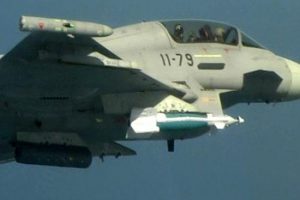
These achievements demonstrate the strong will of the Air Force to maximize the capabilities of the C.16 arms system in the shortest time possible. They bring forward the entry into service of the Tranche-2 planes with new capabilities – aircraft that have been developed by means of an international programme and the parallel implementation of organic improvements made to the Tranche-1 aircraft.
Albacete, Air Base is also playing a key role in enhancing Eurofighter integration as well.
Four nations (Germany, Italy, Spain and UK) of the European Air Group (EAG) conducted a multinational exercise, VOLCANEX Eurofighter Typhoon Interoperability Project (ETIP) LIVEX 15, from 14 – 18 September at Albacete Air Base (Spain).
The aim was to strengthen Eurofighter/Typhoon interoperability and standardization between the EAG nations through the use of common Standard Operating Procedures (SOP), and to familiarize ground crews on other nations AGE (Aircraft Ground Equipment) ,“Turn around” and QRA procedures.
The key to success in multinational operations is a common understanding and efficient coordination and communications between nations of what to do and how to do it.
The EAG, consisting of the Air Forces of Belgium, France, Germany, Italy, The Netherlands, Spain, and the United Kingdom, seeks to improve the operational capabilities of the Parties’ Air Forces to carry out operations in pursuit of shared interests.
One way of achieving this goal is by developing common doctrines and procedures. VOLCANEX is the European Air Group’s name for current and future multinational exercises on which it seeks to refine and validate its developed products and procedures.
http://www.euroairgroup.org/project/volcanexdobex-livex-2016-2/
During a visit to the European Air Group at High Wycombe earlier this year, we discussed the approach with officers of the EAG involved in the effort.
But now that we operate more together, we need clear common operating procedures, notably with regard to maintenance of the aircraft.
In turn, this drives a wedge in common modernization which needs to be done with the broader fleet.”
The approach is based on sharing information and to get the pilots and maintainers to together to share experiences and to shape common standards.
And from our visit to Albacete, it is clear that shared information among the partners is important as well in operations such as the Baltic Air Patrol as well.



